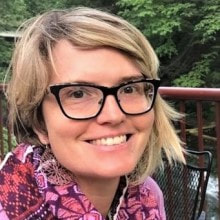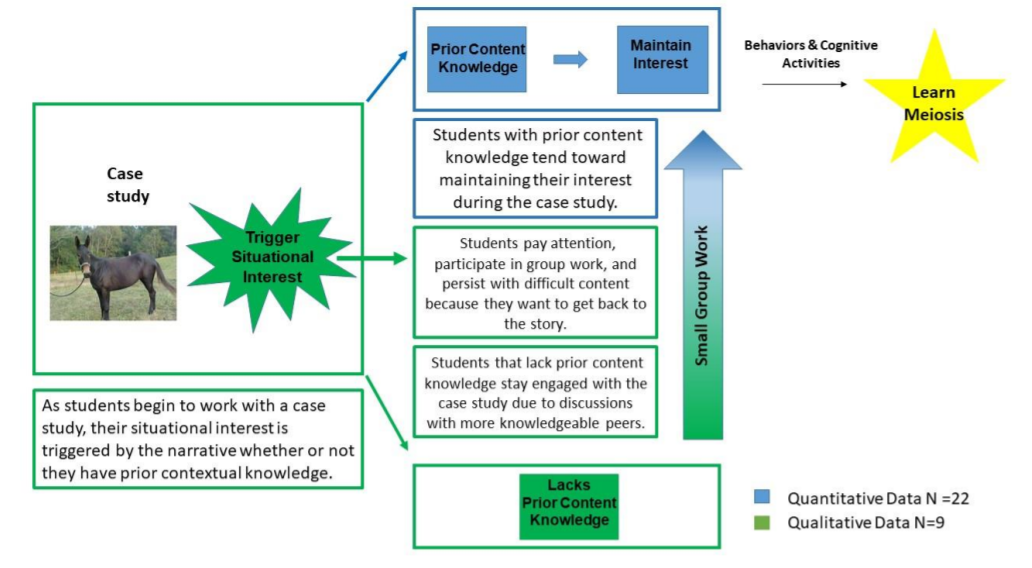 written by: Lasair ni Chochlain Case studies are one teaching tool that can be utilized to engage students, improve learning outcomes and inclusion in the classroom. Dr. Ally Hunter presented her work exploring the effectiveness of case study pedagogy at a Department of Entomology seminar earlier this semester. Dr. Hunter began this work in her doctoral dissertation, completed at University of Massachusetts – Amherst. Now a postdoctoral fellow at UMass Amherst, she utilizes case studies in her undergraduate science classrooms to promote inclusive pedagogy. The advantage in using case studies in scientific teaching is that the stories, with rich narratives, convey scientific content and concepts while also contributing to the maintenance of situational interest which facilitates undergraduate learning. Here, we dive deeper into the methodology of Dr. Hunter’s educational research, to illustrate how her findings can be applied in entomology classrooms and beyond. Case studies are detailed accounts of real-world situations, designed to prompt further analysis or teach concepts. They are common in medicine and business education but can be powerful tools in scientific education as well. Dr. Hunter’s research has examined if and how case studies improve student outcomes in college classrooms. As part of Dr. Hunter’s dissertation, twenty-five undergraduate students were selected, at a public and state-affiliated Mid-Atlantic university, in a general introductory biology course for nonmajors called: Science for Citizen Leaders. All 25 students completed quantitative assessments, and a subset of nine students were evaluated qualitatively in one-on-one interviews. Dr. Hunter’s 2018 research measured the success of case study pedagogy in several quantitative and qualitative ways. Quantitative data was collected to understand prior knowledge of students and whether they had contextual knowledge (i.e., familiar with non-scientific elements of the case study). Situational interest, beliefs toward the case study pedagogy, and the role of the narrative on students learning were also assessed. The quantitative assessments used were a meiosis concept inventory, a transfer of knowledge question (to test applied knowledge), and 33 questions measuring student perceptions of their own learning. There was a strong positive correlation between prior knowledge and student perceptions of learning, and between situational interest and perceptions of learning. These tests were administered post-case study, and follow-up “think-a-loud” interviews were conducted with nine students to collect more qualitative data. If case studies are going to be used as an effective tool in the classroom, it is important that they are useful in communicating the material of science classrooms. But, in addition, to communicating material, case studies can also be effective in fostering inclusion in science classrooms. Dr. Hunter has used subsequent in-depth interviews using the “think-aloud” method. The think-a-loud method (described by Van Someren, M. W., Barnard, Y. F., & Sandberg, J. A. C., 1994) is a tool for understanding cognitive processes, or in other words, attempting to “look” inside someone’s head. The nine students interviewed were solicited through a volunteer sign-up sheet two weeks after the completion of the case study. The goal of these interviews was to ask the students questions about the case study experience and allow them to explain their thoughts and feelings about the learning process.  Figure 2. Flowchart of biology student’s learning with case study pedagogy, with the end result of understanding meiosis. Prior knowledge of case study content was an important predictor of maintained interest in learning. For students lacking this knowledge, small group work facilitated discussions with peers and therefore continued engagement. (Excerpted from Hunter, 2018) Figure 2 illustrates the student learning process, informed by both the qualitative and quantitative results of Dr. Hunter’s writing. The case study successfully caught the interest of the students, even if they were lacking prior content knowledge. Small group work with more knowledgeable peers and a desire to get back to the narrative helped students stay engaged. This work demonstrated the effectiveness of case studies in science classrooms and highlighted some factors that are important in ensuring this efficacy. Further, it presented a conceptual framework for how students learn through case studies in the undergraduate setting. Dr. Hunter and collaborators have continued this promising work and looked more closely at how case study pedagogy can be an inclusive pedagogy. To test this, undergraduates across an introductory biology course and an upper-level microbiology course were exposed to three case studies. One of these was the same case study used in the first study, about mules. The other two case studies were about cheese and genetically modified papaya. The mule and papaya case studies were taught in the general biology course, while the cheese case study was taught in the microbiology course. For this research, the authors developed a new scale to measure feelings of inclusion. Nine different aspects were used to capture this measurement, including whether a student shared their ideas, raised their hand, or felt included in the group work. For all three case studies, a significant positive relationship was found between the student’s perception of the narrative in their learning and their feelings of inclusion, although the strength of this relationship varied (Hunter & Zwick, under review). Overall, when students felt that that the narrative is significant to their learning, they reported higher feelings of inclusion. There was a moderate to strong relationship between pedagogical features and the feelings of inclusion for all three studies, meaning that when students perceived group work, discussion, and problem-solving to be beneficial to their learning, they reported greater feelings of inclusion. (Hunter & Zwick, under review)  Figure 3. Conceptual framework for the importance of students relating to the mule case study. A well-written, relatable story can not only result in successful transfer of scientific knowledge but can also cultivate feelings of inclusion in the classroom. (Figure excerpted from Hunter and Zwick, 2019 poster) When thoughtfully designed and taught, case studies can foster inclusion by bringing relatable stories into the classroom which allow all students to make connections using their prior experience and not just prior biology content knowledge. The narrative offers an avenue for all students to engage with the content and not exclude students who may already be feeling threats to their belonging in STEM classrooms. Narratives can also be used to show students that people from diverse backgrounds with diverse perspectives are not only accepted, but belong in STEM fields, by showcasing a range of lived experience beyond the dominant culture-centric norms that are perpetuated by STEM culture (i.e., the male doctor, female nurse trope). Dr. Hunter and her colleagues call for the development of culturally relevant case studies where the narratives showcase and spotlight the diverse world we live in and particularly narratives that support our BIPOC, LGBTQ+, and students with disabilities to feel they belong in the STEM community. The National Center for Case Study Teaching maintains a database which, as of this writing, contains over 900 peer-reviewed case studies. While many can be used in science classrooms, there are few entomologically-focused case studies in the database. Dr. Hunter encouraged our department to include case studies in teaching, but also to consider designing case studies to use in the Entomology courses and contribute to the database. Case studies can include many diverse perspectives and backgrounds and be a tool for learning but also a tool for inclusion in STEM education.
References Hunter, Ally, "THE ROLE OF PRIOR KNOWLEDGE, SITUATIONAL INTEREST, AND CASE STUDY PEDAGOGY IN THE UNDERGRADUATE BIOLOGY CLASSROOM." (2018). Doctoral Dissertations. 1247. https://scholarworks.umass.edu/dissertations_2/1247 Hunter, A & Zwick, M. (paper) Case Study Pedagogy as Inclusive Pedagogy: An Entry Point for STEM Faculty to Build Inclusive Classrooms. NARST Annual Conference, under review. Hunter, A & Zwick, M. (poster) Case Study Pedagogy and Learning Outcomes: A Framework for Teaching Biology with Narratives. National Association for Biology Teachers Professional Development Conference. November 14-17, 2019. Chicago, IL. Van Someren, M. W., Barnard, Y. F., & Sandberg, J. A. C., The think aloud method: a practical approach to modelling cognitive processes. 1994. Londen: Academic Press. https://hdl.handle.net/11245/1.103289 Author Lasair ni Chochlain is a first-year PhD student in the Hamby Lab, interested in plant-insect interactions and pest management in soybean. Comments are closed.
|
Categories
All
Archives
June 2024
|
Department of Entomology
University of Maryland
4112 Plant Sciences Building
College Park, MD 20742-4454
USA
Telephone: 301.405.3911
Fax: 301.314.9290
University of Maryland
4112 Plant Sciences Building
College Park, MD 20742-4454
USA
Telephone: 301.405.3911
Fax: 301.314.9290

 RSS Feed
RSS Feed




